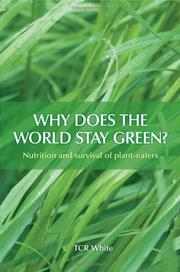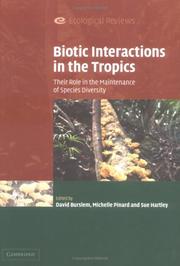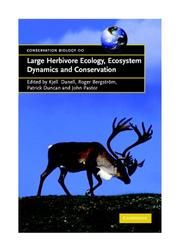| Listing 1 - 10 of 14 | << page >> |
Sort by
|
Book
ISBN: 9535110527 9535153595 Year: 2013 Publisher: IntechOpen
Abstract | Keywords | Export | Availability | Bookmark
 Loading...
Loading...Choose an application
- Reference Manager
- EndNote
- RefWorks (Direct export to RefWorks)
Studies of herbivory provide important insights into fundamental questions in many areas of the biological sciences. The focus on natural systems is more effective for the prediction of potential changes in ecosystems, given that agricultural systems are designed to create an equilibrium that optimizes the productive process. Given the ramifications of the processes related to herbivory, studies based on complementary approaches are necessary for a better understanding of the different aspects of the ecological process. This book attempts to expand on these different aspects of herbivory by presenting a multidisciplinary approach to a number of different themes, focusing on topics that range from basic research in natural habitats to the intrinsic relationships between animals and plants in agricultural systems.
Animal-plant relationships. --- Animal-plant interactions --- Animals and plants --- Interactions, Animal-plant --- Plant-animal interactions --- Plant-animal relationships --- Plants and animals --- Relationships, Animal-plant --- Ecology --- Animal behaviour

ISBN: 1283154676 9786613154675 064309315X 9780643093157 9781283154673 0643091580 9780643091580 0643099816 Year: 2005 Publisher: Collingwood, Vic. CSIRO Pub.
Abstract | Keywords | Export | Availability | Bookmark
 Loading...
Loading...Choose an application
- Reference Manager
- EndNote
- RefWorks (Direct export to RefWorks)
Explore a controversial theory that challenges the common understanding of natural population control in herbivores.
Population biology. --- Animal-plant relationships. --- Nitrogen in animal nutrition. --- Animal nutrition --- Animal-plant interactions --- Animals and plants --- Interactions, Animal-plant --- Plant-animal interactions --- Plant-animal relationships --- Plants and animals --- Relationships, Animal-plant --- Ecology --- Biology
Book
ISBN: 3030866874 3030866882 Year: 2022 Publisher: Cham, Switzerland : Springer,
Abstract | Keywords | Export | Availability | Bookmark
 Loading...
Loading...Choose an application
- Reference Manager
- EndNote
- RefWorks (Direct export to RefWorks)
Animal-plant relationships. --- Animal-plant interactions --- Animals and plants --- Interactions, Animal-plant --- Plant-animal interactions --- Plant-animal relationships --- Plants and animals --- Relationships, Animal-plant --- Ecology --- Lepidòpters --- Relacions animal-planta
Book
ISBN: 1623496454 9781623496456 9781623496449 Year: 2018 Publisher: College Station
Abstract | Keywords | Export | Availability | Bookmark
 Loading...
Loading...Choose an application
- Reference Manager
- EndNote
- RefWorks (Direct export to RefWorks)
Flowers have played an important role in human culture for thousands of years, symbolizing love, sorrow, and renewal. They provide bursts of color to homes and gardens and convey messages to friends, family, and significant others. Yet we often overlook their real purpose--why do flowers exist and why are they certain colors, shapes, and smells? In nature, flowers are key to healthy ecosystems and play a functional role, increasing a plant's chances for survival. Flowers have evolved to attract specific pollinators and to take advantage of climate variables and animal migration to disperse seeds, ensuring that the species will survive. These fine-tuned methods have evolved over a long period of time, and the importance of pollination and seed dispersal to a healthy environment cannot be overstated. As climate change places pressure on animals and plants, it is also challenging these methods flowers have developed for survival. The Fogdens describe flowers' functions and structures, pollination and seed dispersal methods, and close the book with descriptions of their favorite tropical flowers. The information is illustrated with intimate photographs of flowers and pollinators.
Animal-plant relationships. --- Human-plant relationships. --- Flowers. --- Blooms (Flowers) --- Blossoms --- Flowering plants --- Inflorescences --- Plants --- Floral products --- Man and plants --- Man-plant relationships --- Plant-human relationships --- Plant-man relationships --- Plants and man --- Relationships, Human-plant --- Human beings --- Botany, Economic --- Ethnobotany --- Synanthropic plants --- Animal-plant interactions --- Animals and plants --- Interactions, Animal-plant --- Plant-animal interactions --- Plant-animal relationships --- Plants and animals --- Relationships, Animal-plant --- Ecology

ISBN: 0521847079 0521609852 9780521609852 9780521847070 9780511541971 051154197X 9780511128011 0511128010 0511127480 9780511127489 1107152607 1280434902 9786610434909 051120017X 0511182538 0511300603 Year: 2005 Publisher: Cambridge Cambridge University Press
Abstract | Keywords | Export | Availability | Bookmark
 Loading...
Loading...Choose an application
- Reference Manager
- EndNote
- RefWorks (Direct export to RefWorks)
Tropical ecosystems house a significant proportion of global biodiversity. To understand how these ecosystems function we need to appreciate not only what plants, animals and microbes they contain, but also how they interact with each other. This volume, first published in 2005, synthesises the state of knowledge in this area, with chapters providing reviews or case studies drawn from research conducted in both Old and New World tropics and including biotic interactions among taxa at all trophic levels. In most chapters plants (typically trees) are the starting point, but, taken together, the chapters consider interactions of plants with other plants, with micro-organisms and with animals, and the inter-relationships of human-induced disturbance with interactions among species. An underlying theme of the volume is the attempt to understand the maintenance of high diversity in tropical regions, which remains one of the most significant unexplained observations in ecological studies.
Ecology --- Biotic communities --- Species diversity --- Ecologie --- Ecosystèmes --- Diversité des espèces --- ECO Ecology --- biodiversity --- ecology --- plant-animal relationships --- tropical forests --- tropical regions --- 574.4 --- Terrestrial biocoenoses and ecosystems. Biogeocoenoses. Biogeochemical cycles. Food chains --- 574.4 Terrestrial biocoenoses and ecosystems. Biogeocoenoses. Biogeochemical cycles. Food chains --- Ecosystèmes --- Diversité des espèces --- Diversity, Species --- Richness, Species --- Species richness --- Biodiversity --- Biocenoses --- Biocoenoses --- Biogeoecology --- Biological communities --- Biomes --- Biotic community ecology --- Communities, Biotic --- Community ecology, Biotic --- Ecological communities --- Ecosystems --- Natural communities --- Population biology
Book
ISBN: 140088120X 9781400881208 0691158452 Year: 2016 Publisher: New Jersey Princeton University Press
Abstract | Keywords | Export | Availability | Bookmark
 Loading...
Loading...Choose an application
- Reference Manager
- EndNote
- RefWorks (Direct export to RefWorks)
The dazzling variation in plant chemistry is a primary mediator of trophic interactions, including herbivory, predation, parasitism, and disease. At the same time, such interactions feed back to influence spatial and temporal variation in the chemistry of plants. In this book, Mark Hunter provides a novel approach to linking the trophic interactions of organisms with the cycling of nutrients in ecosystems.Hunter introduces the concept of the "phytochemical landscape"-the shifting spatial and temporal mosaic of plant chemistry that serves as the nexus between trophic interactions and nutrient dynamics. He shows how plant chemistry is both a cause and consequence of trophic interactions, and how it also mediates ecosystem processes such as nutrient cycling. Nutrients and organic molecules in plant tissues affect decomposition rates and the fluxes of elements such as carbon, nitrogen, and phosphorus. The availability of these same nutrients influences the chemistry of cells and tissues that plants produce. In combination, these feedback routes generate pathways by which trophic interactions influence nutrient dynamics and vice versa, mediated through plant chemistry. Hunter provides evidence from terrestrial and aquatic systems for each of these pathways, and describes how a focus on the phytochemical landscape enables us to better understand and manage the ecosystems in which we live.Essential reading for students and researchers alike, this book offers an integrated approach to population-, community-, and ecosystem-level ecological processes.
Variation (Biology) --- Environmental chemistry. --- Botanical chemistry. --- Phytochemicals. --- Animal-plant relationships. --- Autotrophic bacteria. --- Heterotrophic bacteria. --- Bacteria, Heterotrophic --- Bacteria --- Bacteria, Autotrophic --- Animal-plant interactions --- Animals and plants --- Interactions, Animal-plant --- Plant-animal interactions --- Plant-animal relationships --- Plants and animals --- Relationships, Animal-plant --- Ecology --- Botanical chemicals --- Plant chemicals --- Chemicals --- Botanical chemistry --- Phytochemistry --- Plant biochemistry --- Plant chemistry --- Biochemistry --- Botany --- Phytochemicals --- Plant biochemical genetics --- Chemistry, Environmental --- Chemistry --- Biological variation --- Biology --- Heredity --- Genetics --- Mutation (Biology)
Periodical
ISSN: 00298549 14321939 Year: 1968 Publisher: Heidelberg Springer
Abstract | Keywords | Export | Availability | Bookmark
 Loading...
Loading...Choose an application
- Reference Manager
- EndNote
- RefWorks (Direct export to RefWorks)
Publishes ecological research of international interest. 4 vols. (4 issues each) / year
General ecology and biosociology --- Environmental protection. Environmental technology --- Ecology --- Ecologie --- Periodicals --- Périodiques --- Ecology. --- Environnement --- Écologie --- Ökologie. --- Zeitschrift. --- Online-Publikation. --- #TS:WBIB --- 57 --- 574 --- Biological sciences in general --- General ecology. Biocoenology. Hydrobiology. Biogeography --- Environmental Sciences. --- Ecology, --- Ecosystems & Ecology --- Botany. --- Life Sciences. --- Environmental Sciences --- Life Sciences --- Biology --- Botany --- Germany --- behavioural ecology --- community ecology --- ecological methods --- ecology --- ecophysiology --- ecosystems --- periodical --- plant-animal relationships --- population ecology --- 574 General ecology. Biocoenology. Hydrobiology. Biogeography --- Périodiques --- EJECOLO EPUB-ALPHA-O EPUB-PER-FT JSTOR-E SPRINGER-E --- Écologie générale et biodiversité --- L'environnement et sa protection

ISBN: 9780521536875 0521536871 9780521830058 0521830052 9780511617461 0511218966 9780511218965 9780511220968 0511220960 0511219644 9780511219641 0511220693 9780511220692 0511617461 1280479965 9781280479960 1107160448 9786610479962 0511324294 9781107160446 6610479968 9780511324291 Year: 2006 Publisher: Cambridge, UK Cambridge University Press
Abstract | Keywords | Export | Availability | Bookmark
 Loading...
Loading...Choose an application
- Reference Manager
- EndNote
- RefWorks (Direct export to RefWorks)
Most large herbivores require some type of management within their habitats. Some populations of large herbivores are at the brink of extinction, some are under discussion for reintroduction, whilst others already occur in dense populations causing conflicts with other land use. Large herbivores are the major drivers for forming the shape and function of terrestrial ecosystems. This 2006 book addresses the scientifically based action plans to manage both the large herbivore populations and their habitats worldwide. It covers the processes by which large herbivores not only affect their environment (e.g. grazing) but are affected by it (e.g. nutrient cycling) and the management strategies required. Also discussed are new modeling techniques, which help assess integration processes in a landscape context, as well as assessing the consequences of new developments in the processes of conservation. This book will be essential reading for all involved in the management of both large herbivores and natural resources.
Ungulates --- Herbivores --- Plants --- Animal-plant relationships. --- Ongulés --- Plantes, Effets du pâturage sur les --- Plantes, Effets du broutement sur les --- Relations animal-plante --- Ecology. --- Effect of grazing on. --- Effect of browsing on. --- Conservation. --- Ecologie --- Conservation --- Herbivora --- Herbivorous animals --- Phytophagous animals --- Plant-eating animals --- Plant-feeding animals --- Animals --- Habitat --- Habitat. --- Hoofed animals --- Hoofed mammals --- Hooved animals --- Hooved mammals --- Ungulata --- Mammals --- Animal-plant interactions --- Animals and plants --- Interactions, Animal-plant --- Plant-animal interactions --- Plant-animal relationships --- Plants and animals --- Relationships, Animal-plant --- Ecology --- Flora --- Plant kingdom --- Plantae --- Vascular plants --- Vegetable kingdom --- Vegetation --- Wildlife --- Organisms --- Botany --- Plants, Effect of grazing on --- Grazing

ISBN: 0226424979 1281223719 9786611223717 9780226424972 9781281223715 6611223711 9780226424965 0226424960 9780226424958 0226424952 Year: 1997 Publisher: Chicago University of Chicago Press
Abstract | Keywords | Export | Availability | Bookmark
 Loading...
Loading...Choose an application
- Reference Manager
- EndNote
- RefWorks (Direct export to RefWorks)
Plants face a daunting array of creatures that eat them, bore into them, and otherwise use virtually every plant part for food, shelter, or both. But although plants cannot flee from their attackers, they are far from defenseless. In addition to adaptations like thorns, which may be produced in response to attack, plants actively alter their chemistry and physiology in response to damage. For instance, young potato plant leaves being eaten by potato beetles respond by producing chemicals that inhibit beetle digestive enzymes. Over the past fifteen years, research on these induced responses to herbivory has flourished, and here Richard Karban and Ian T. Baldwin present the first comprehensive evaluation and synthesis of this rapidly developing field. They provide state-of-the-discipline reviews and highlight areas where new research will be most productive. Their comprehensive overview will be welcomed by a wide variety of theoretical and applied researchers in ecology, evolutionary biology, plant biology, entomology, and agriculture.
Animal-plant relationships. --- Herbivores --- Plant defenses. --- Defense mechanisms, Plant --- Defenses, Plant --- Mechanisms, Plant defense --- Plant defense mechanisms --- Plant self-protection --- Plants --- Self-defense in plants --- Self-protection in plants --- Plant ecology --- Dangerous plants --- Poisonous plants --- Herbivora --- Herbivorous animals --- Phytophagous animals --- Plant-eating animals --- Plant-feeding animals --- Animals --- Animal-plant interactions --- Animals and plants --- Interactions, Animal-plant --- Plant-animal interactions --- Plant-animal relationships --- Plants and animals --- Relationships, Animal-plant --- Ecology --- Ecology. --- Defenses --- herbivores, vegetables, plants, flora, plant, eating, food, animals, fauna, shelter, nature, natural world, defenses, defense, response, chemistry, physiology, biology, botany, thorns, adaptation, darwin, selection, genes, chemical, enzyme, evaluation, synthesis, academic, scholarly, research, college, university, higher education, textbook, agriculture, resistance.
Book
ISBN: 904819315X 9786612994654 1282994654 9048193168 Year: 2011 Publisher: Dordrecht, the Netherlands ; New York : Springer,
Abstract | Keywords | Export | Availability | Bookmark
 Loading...
Loading...Choose an application
- Reference Manager
- EndNote
- RefWorks (Direct export to RefWorks)
This new book takes us through a journey from early life to modern agriculture. The thirty eight authors present current studies on the interrelation of plants-animals. This topic has always fascinated man, as evidenced even by the first chapters of Genesis. The world of aqueous and terrestrial fauna appeared on early earth only after the flora covered the areas with the green pigmentation. Almost all life depends upon sunlight via the photosynthesis of the botanical world. We read abut the harnessing of bee pollination of crops to make it an essential component of modern agriculture endeavor. Some plants seduce insects for pollination by their appearance (e.g., disguised orchids entice visitors); there is the production of sweet nectar as a bribe in flowers to attract bees, butterflies, and honey-sucking birds. A particular outstanding phenomena are the carnivorous plants that have developed trapping and digesting systems of insects and higher animals.
Animal-plant relationships. --- Evolution (Biology). --- Animal-plant relationships --- Evolution (Biology) --- Symbiosis --- Earth & Environmental Sciences --- Agriculture --- Ecology --- Agriculture - General --- Herbivores --- Symbiosis. --- Ecology. --- Consortism --- Herbivora --- Herbivorous animals --- Phytophagous animals --- Plant-eating animals --- Plant-feeding animals --- Animal-plant interactions --- Animals and plants --- Interactions, Animal-plant --- Plant-animal interactions --- Plant-animal relationships --- Plants and animals --- Relationships, Animal-plant --- Life sciences. --- Agriculture. --- Ecosystems. --- Plant ecology. --- Life Sciences. --- Plant Ecology. --- Biology --- Symbiogenesis --- Animals --- Endangered ecosystems. --- Botany --- Plants --- Threatened ecosystems --- Biotic communities --- Nature conservation --- Balance of nature --- Bionomics --- Ecological processes --- Ecological science --- Ecological sciences --- Environment --- Environmental biology --- Oecology --- Environmental sciences --- Population biology --- Farming --- Husbandry --- Industrial arts --- Life sciences --- Food supply --- Land use, Rural --- Phytoecology --- Vegetation ecology --- Ecology . --- Biocenoses --- Biocoenoses --- Biogeoecology --- Biological communities --- Biomes --- Biotic community ecology --- Communities, Biotic --- Community ecology, Biotic --- Ecological communities --- Ecosystems --- Natural communities --- Floristic ecology
| Listing 1 - 10 of 14 | << page >> |
Sort by
|

 Search
Search Feedback
Feedback About UniCat
About UniCat  Help
Help News
News